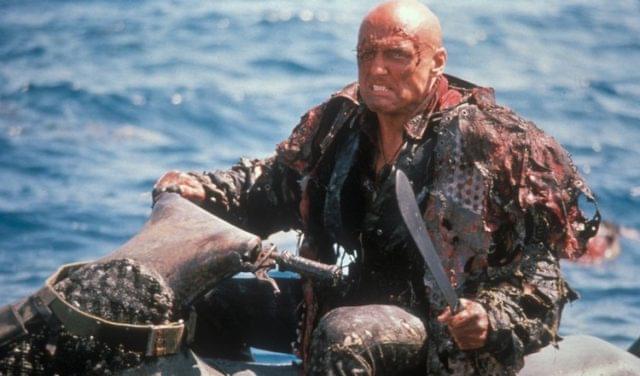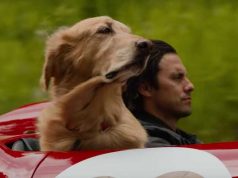
“Waterworld” is notorious for being a big-budget flop and an embarrassment to the otherwise pristine and unimpeachable career of master thespian Kevin Costner. But there’s something that gets overlooked all too often in discussions of the film, which is this: It begins with Costner drinking his own urine.
Now, I have not seen every film ever made, so I cannot estimate how many of them have featured scenes of their lead actors imbibing pee. But I will say, categorically and without exception, that no GOOD movie has ever included such a scene. If I may employ a bit of circular reasoning, you can’t make a good movie that involves pee-drinking. Why? Because pee-drinking automatically makes the movie bad. I HAVE DECREED IT SO.
The wee-wee sipper is known only as the Mariner, possibly because he was once a fan of the Seattle baseball team, though it’s unlikely such a person would exist in any world, let alone a post-apocalyptic one. “Waterworld” is set in the future, where everything is exactly as Al Gore predicted: the ice caps have melted, the Earth is flooded, and people float around the endless seas subsisting on fish, leftover foodstuffs, and whizz.
It’s not clear how long the Earth has been like this. The roving band of marauders known as Smokers still have an ample supply of cigarettes and other items that require solid ground to manufacture, so there must have been dry land fairly recently. On the other hand, the Mariner is a mutant with webbed toes and functional gills, which means enough time has passed for the human race to start evolving and adapting to the new climate. On yet a third hand, for the ENTIRE world to be buried in water, mountains included, the sea levels would have to rise THOUSANDS of feet — quite a bit more than the few hundred feet that they would actually rise if the polar ice caps really did melt. I find it interesting that the movie makes a point of explaining where ocean-dwelling humans get their drinking water (i.e., their own bladders), but nothing else.
The Mariner lives alone on his boat and avoids human contact except to trade at outposts. While on one such visit, he and the outpost are attacked by the Smokers, who live on an oil tanker that apparently also has an oil refinery, since they have sufficient gasoline to power their jet skis and airplanes. Somehow they’re making ammunition for their guns, too. Oh, and they have guns. Oh, and they have accepted Dennis Hopper as their leader, which I have always taken as a sure sign that a society is doomed. (Al Gore also predicted that in the future men will heed the words of Dennis Hopper.)
In the process of escaping the battle, the Mariner takes on two passengers: a woman named Helen (Jeanne Tripplehorn, from the fearsome triple-horned people of the Amazon) and a little girl named Enola (Tina Majorino). Enola has a tattoo on her back that some people believe is a map to dry land. Enola doesn’t remember getting the tattoo, possibly because it happened when she was drunk on Spring Break. Since they don’t have enough drinking water to last however long it takes to find the mythical dry land, and since nobody has to “go” bad enough to boost the supply, the Mariner proposes throwing Enola overboard. Helen takes the opposing viewpoint and offers her body to the Mariner in exchange for letting Enola live. The Mariner declines this offer but lets Enola stay aboard anyway.
But don’t let that fool you into thinking the Mariner is a class act! Indeed, he puts the “ick” in “ichthyological deformity.” He has a box of crayons on his boat and is very possessive of them, going so far as to throw Enola into the water after she uses them, even after saying he wouldn’t. Evidently the crayon usage was THE LAST STRAW. Enola can’t swim, either, which is crazy. You live in a world entirely covered by water, yet you can’t swim? That’s like living in Miami and not knowing how to fire a gun.
Later, they encounter an insane trader on another boat who offers the Mariner a couple sheets of paper (a rare artifact) in exchange for a half-hour alone with Helen. Helen isn’t really the Mariner’s property to lend out, but this does not stop him from doing so. After she fights off the man’s advances, the Mariner takes her underwater — he can breathe, and he puts her in a bubble (which he happens to have on hand, I guess, in case he has visitors who want to go sightseeing?) — and shows her the ruined cities of Earth that now lie hundreds of feet below the ocean’s surface. “Waterworld” is famous for being the most expensive movie ever made up to that point, but I feel safe in saying none of that $175 million was spent on the special effects in this sequence, which looks like a cartoon of Kevin Costner and Jeanne Tripplehorn drawn over stock footage of water.
Anyway, while the Mariner and Helen are gone, the Smokers show up to abduct Enola and follow her back-map to dry land. The adults knew the Smokers were after the girl, so you could question their parenting skills for leaving her alone while they frolicked underwater. Then again, the Mariner already tried to drown the girl and pimp out the woman, so there’s every chance Enola will be in better hands with the Smokers anyway. The map is on her back, so they’ll at least keep that part of her safe.
The whole film has depicted the Mariner as a loathsome, awful person, with the apparent intent of softening him up by the end. Sure enough, when Enola is taken, the Mariner goes off to rescue her. Dennis Hopper marvels at the Mariner’s ability not to die, saying, “He’s like a turd that won’t flush” — an unlikely choice of simile coming from a person who has never encountered dry land, indoor plumbing, or toilets. The Mariner does indeed kill the Smokers and save Enola, meaning that at last he has learned to love — or, at least, learned to not drown little girls anymore. Baby steps, right?
— Film.com





